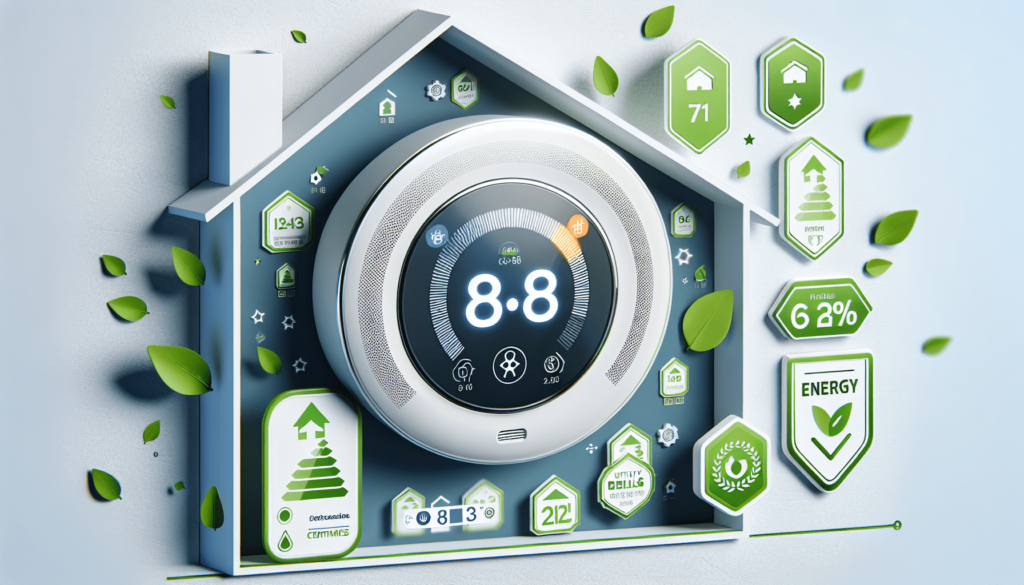If you’re in the market for a new smart thermostat, then you may be wondering about its energy efficiency ratings. It’s important to choose a thermostat that not only offers convenient features but also helps you save on energy bills. Energy efficiency ratings can give you an idea of how well a smart thermostat can optimize your energy usage and reduce wasteful consumption. In this article, we will explore the various energy efficiency ratings for smart thermostats and discuss why they matter in making an informed purchasing decision. So, let’s dive in and discover how these ratings can help you make your home more energy-efficient and comfortable.

What is Energy Efficiency Rating?
Definition of energy efficiency rating
Energy efficiency rating refers to a measurement or scale that indicates how efficiently a device operates in terms of energy consumption. It helps consumers understand how much energy a particular product uses, and how that usage compares to similar products. For smart thermostats, energy efficiency ratings provide valuable information about the device’s ability to regulate and optimize energy usage, leading to potential energy savings and reduced environmental impact.
Importance of energy efficiency rating for smart thermostats
Energy efficiency ratings are particularly important for smart thermostats due to their role in controlling heating and cooling systems. These devices have the potential to significantly impact household energy consumption, and therefore, understanding their energy efficiency is crucial for making informed purchasing decisions. With rising energy costs and growing concerns about climate change, choosing a smart thermostat with a high energy efficiency rating can help homeowners save money on their energy bills and contribute to a more sustainable future.
Understanding the Energy Efficiency Labels
Different energy efficiency labeling systems
Energy efficiency labels vary across different regions and countries. One commonly recognized labeling system is the Energy Star certification, predominantly used in the United States. In Europe, the European Energy Labeling scheme is widely employed, while Canada utilizes the EnerGuide Labeling system. Each system has its unique criteria and rating scales, but they all aim to provide consumers with easily understandable information about the energy efficiency of products.
Meaning of different energy efficiency ratings
Energy efficiency ratings are typically given as a numerical score or a letter grade, representing the device’s efficiency level. Higher ratings or grades indicate greater energy efficiency. These ratings consider factors such as electricity consumption, performance, and features of the smart thermostat. It’s important to note that energy efficiency ratings are relative within the same category of products, so a higher-rated smart thermostat will consume less energy compared to others in its class.

Common Energy Efficiency Rating Scales
Energy Star certification
The Energy Star certification is a widely recognized symbol of energy efficiency in the United States. To qualify for this certification, smart thermostats must meet strict standards set by the Environmental Protection Agency (EPA). Energy Star certified thermostats are designed to use less energy without sacrificing performance and functionality. These devices not only help reduce energy bills but also have a positive impact on the environment by reducing greenhouse gas emissions.
European Energy Labeling
In Europe, smart thermostats are labeled using the European Energy Labeling scheme. This system assigns energy efficiency ratings from A+++ (most efficient) to D (least efficient). The labels also provide additional information about energy consumption, noise level, and features. The European Energy Labeling scheme assists consumers in making informed choices by clearly displaying the energy efficiency of various smart thermostat models.
Canadian EnerGuide Labeling
Canada’s EnerGuide Labeling system assigns energy efficiency ratings to various appliances, including smart thermostats. The ratings are based on the device’s energy efficiency performance compared to similar models. EnerGuide labels provide valuable information to Canadian consumers, allowing them to compare different products and choose the most energy-efficient option for their home.
Factors Influencing Energy Efficiency Ratings
Thermostat features affecting energy efficiency
The features of a smart thermostat play a significant role in its energy efficiency rating. Devices with advanced features such as adaptive algorithms, temperature sensors, and occupancy sensors are capable of accurately and efficiently regulating heating and cooling systems. Additionally, smart thermostats with Wi-Fi connectivity enable remote access and control, further optimizing energy usage by allowing users to adjust temperature settings according to their needs and schedules.
Programming capabilities
Smart thermostats with programmable settings allow users to automate temperature adjustments based on their daily routines. This feature helps avoid unnecessary energy consumption by automatically adjusting the temperature when occupants are away or asleep. By setting different temperature profiles for various times of the day, users can ensure optimal energy efficiency without sacrificing comfort.
Room occupancy sensors
Some smart thermostats come equipped with room occupancy sensors, which detect activity in different zones of the house. These sensors enable the device to adjust heating or cooling settings only in occupied areas, reducing energy waste in unoccupied rooms. This capability ensures that energy is directed where it is needed, contributing to greater energy efficiency and cost savings.
Built-in learning algorithms
Smart thermostats with built-in learning algorithms analyze user behavior and adjust temperature settings accordingly. Over time, these devices learn the household’s preferred temperature patterns, making automatic adjustments to conserve energy without compromising comfort. Learning algorithms can adapt to changes in occupancy, weather conditions, and other factors to continually optimize energy usage, resulting in improved energy efficiency and reduced energy consumption.

Benefits of High Energy Efficiency Ratings
Savings on energy bills
One of the primary benefits of high energy efficiency ratings is the potential for significant savings on energy bills. Smart thermostats with superior energy efficiency can help homeowners reduce their heating and cooling costs by using less energy to maintain comfortable indoor temperatures. The savings can add up over time, making an energy-efficient smart thermostat a wise long-term investment.
Reduced environmental impact
By choosing a smart thermostat with a high energy efficiency rating, you are actively contributing to reduced environmental impact. Energy-efficient devices consume less electricity, leading to lower greenhouse gas emissions. With the increasing focus on sustainability and mitigating climate change, making eco-friendly choices like investing in energy-efficient smart thermostats supports global efforts to create a greener future.
Improved comfort and convenience
High energy efficiency ratings are often associated with advanced features that enhance user comfort and convenience. Smart thermostats allow for precise temperature control and scheduling, ensuring that you can easily create and maintain a comfortable environment in your home. Remote access and control features enable users to adjust settings even when they are away, ensuring a comfortable return while also maximizing energy efficiency.
Comparison of Energy Efficiency Ratings
Top smart thermostats and their energy efficiency ratings
Several smart thermostats are available on the market, each with its own energy efficiency rating. Examples of highly rated smart thermostats include the ecobee SmartThermostat with a rating of Energy Star most efficient, the Google Nest Learning Thermostat with an Energy Star rating, and the Honeywell Home T9 Smart Thermostat also Energy Star certified. These top-rated devices offer a range of features and performance capabilities, all while prioritizing energy efficiency.
Pros and cons of different energy efficiency ratings
Different energy efficiency ratings have their own set of advantages and limitations. High-rated smart thermostats are more likely to provide exceptional energy-saving capabilities, but they may come at a higher cost. On the other hand, lower-rated thermostats may be more budget-friendly but may offer fewer advanced features and potentially consume more energy. Ultimately, choosing the right energy efficiency rating depends on individual preferences, priorities, and budget constraints.

Tips for Choosing an Energy Efficient Smart Thermostat
Consider your heating and cooling system
Before selecting a smart thermostat, it’s essential to consider the type of heating and cooling system you have in your home. Some smart thermostats are designed specifically for certain systems, while others are compatible with a wider range of setups. Understanding the compatibility requirements will ensure a seamless integration and optimal energy efficiency.
Evaluate your energy usage patterns
Take time to evaluate your energy usage patterns and requirements. Consider when and how often your heating or cooling systems are in use, as well as any specific temperature preferences for different areas of your home. By knowing your usage patterns, you can choose a smart thermostat that aligns with your needs and maximizes energy efficiency accordingly.
Research product reviews and ratings
When exploring energy-efficient smart thermostats, make sure to read product reviews and ratings from reputable sources. Reviews often provide insights into the actual performance and energy-saving capabilities of specific models. Pay attention to user experiences, reliability, and energy efficiency testimonials to make an informed decision based on real-world feedback.
Check for rebates and incentives
Many regions and utility companies offer rebates or incentives for purchasing and installing energy-efficient smart thermostats. These incentives can offset the cost of purchasing and encourage the adoption of eco-friendly technology. Check with your local energy provider or government agencies to see if you qualify for any programs that may make an energy-efficient smart thermostat more affordable.
Importance of Proper Installation and Usage
Effect of improper installation on energy efficiency
Even the most energy-efficient smart thermostat can become inefficient if not properly installed. Improper installation can result in inaccurate temperature readings, poor performance, and difficulty maintaining desired temperatures. To ensure optimal energy efficiency, it is recommended to hire a professional or carefully follow the manufacturer’s installation instructions for your specific smart thermostat model.
Optimal usage practices for maximizing energy efficiency
Besides proper installation, optimal usage practices play a vital role in maximizing energy efficiency. Utilize programming features to adjust temperature settings based on your routine and the occupancy of different zones. Take advantage of energy-saving modes when you’re away for extended periods. Regularly update thermostat software to benefit from new energy-saving algorithms and features. By adopting these practices, you can fully utilize the energy efficiency potential of your smart thermostat.

Additional Features and Innovations
Smart zoning capabilities
Some advanced smart thermostats offer smart zoning capabilities, allowing users to divide their homes into different temperature zones. This feature enables precise control of heating and cooling in specific areas, further optimizing energy efficiency. By directing conditioned air only to the areas that need it, smart zoning reduces energy waste and increases comfort in different parts of the house.
Remote access and control
Smart thermostats with remote access and control capabilities provide added convenience and energy savings. With a mobile app, users can adjust temperature settings from anywhere, ensuring optimal comfort upon arrival. Remote access also enables users to turn off heating or cooling when they forgot to do so before leaving, preventing unnecessary energy consumption and reducing utility costs.
Compatibility with other smart home devices
Energy-efficient smart thermostats often integrate seamlessly with other smart home devices, such as voice assistants and home automation systems. This compatibility allows for enhanced automation and coordination between different devices, resulting in better energy management. For example, integrating a smart thermostat with smart blinds can optimize natural lighting and reduce the need for artificial cooling or heating.
Future Trends in Energy Efficiency Ratings
Advancements in technology
As technology continues to advance, energy efficiency ratings are likely to become more refined and accurate. Advanced sensors, algorithms, and machine learning capabilities will further optimize energy usage and provide even higher levels of efficiency. Additionally, emerging technologies like blockchain and artificial intelligence may revolutionize energy management systems, leading to improved energy efficiency ratings for smart thermostats and other devices.
Potential new standards and regulations
The growing awareness of energy consumption and sustainability is likely to result in new standards and regulations for energy efficiency ratings. Governments and regulatory bodies may implement stricter guidelines to ensure that smart thermostats and other appliances meet higher efficiency standards. This push for greater efficiency will benefit consumers by offering more energy-saving options and encouraging manufacturers to continually improve their products.
In conclusion, energy efficiency ratings for smart thermostats are essential for making informed purchasing decisions and optimizing energy usage. High energy efficiency ratings not only lead to significant savings on energy bills but also contribute to reducing environmental impact and improving comfort and convenience. By considering factors such as thermostat features, programming capabilities, and compatibility with your home system, you can choose an energy-efficient smart thermostat that aligns with your needs and values. Proper installation, optimal usage practices, and awareness of additional features and innovations further enhance the energy efficiency potential of these devices. As technology advances, future trends in energy efficiency ratings will continue to push the boundaries of energy-saving capabilities, ultimately leading to a more energy-efficient and sustainable future.










